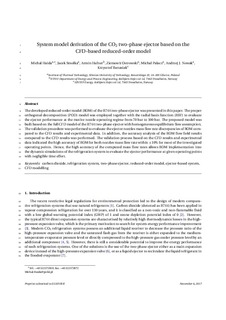| dc.contributor.author | Haida, Michal | |
| dc.contributor.author | Smolka, Jacek | |
| dc.contributor.author | Hafner, Armin | |
| dc.contributor.author | Ostrowski, Zeimowit | |
| dc.contributor.author | Palacz, Michal | |
| dc.contributor.author | Nowak, Andrzej J. | |
| dc.contributor.author | Banasiak, Krzysztof | |
| dc.date.accessioned | 2019-10-08T12:04:53Z | |
| dc.date.available | 2019-10-08T12:04:53Z | |
| dc.date.created | 2017-12-22T10:39:21Z | |
| dc.date.issued | 2018 | |
| dc.identifier.issn | 0360-5442 | |
| dc.identifier.uri | http://hdl.handle.net/11250/2620916 | |
| dc.description.abstract | The developed reduced-order model (ROM) of the R744 two-phase ejector was presented in this paper. The proper orthogonal decomposition (POD) model was employed together with the radial basis function (RBF) to evaluate the ejector performance at the motive nozzle operating regime from 70 bar to 100 bar. The proposed model was built based on the full CFD model of the R744 two-phase ejector with homogeneous equilibrium flow assumption. The validation procedure was performed to evaluate the ejector nozzles mass flow rate discrepancies of ROM compared to the CFD results and experimental data. In addition, the accuracy analysis of the ROM flow field results compared to the CFD results was performed. The validation process based on the CFD results and experimental data indicated the high accuracy of ROM for both nozzles mass flow rate within ±±10% for most of the investigated operating points. Hence, the high accuracy of the computed mass flow rates allows ROM implementation into the dynamic simulations of the refrigeration system to evaluate the ejector performance at given operating points with negligible time effort. © 2017 Elsevier Ltd. All rights reserved. | nb_NO |
| dc.language.iso | eng | nb_NO |
| dc.publisher | Elsevier | nb_NO |
| dc.rights | Attribution-NonCommercial-NoDerivatives 4.0 Internasjonal | * |
| dc.rights.uri | http://creativecommons.org/licenses/by-nc-nd/4.0/deed.no | * |
| dc.title | System model derivation of the CO2 two-phase ejector based on the CFD-based reduced-order model | nb_NO |
| dc.type | Journal article | nb_NO |
| dc.type | Peer reviewed | nb_NO |
| dc.description.version | acceptedVersion | nb_NO |
| dc.source.pagenumber | 941-956 | nb_NO |
| dc.source.volume | 144 | nb_NO |
| dc.source.journal | Energy | nb_NO |
| dc.source.issue | 144 | nb_NO |
| dc.identifier.doi | 10.1016/j.energy.2017.12.055 | |
| dc.identifier.cristin | 1531382 | |
| dc.relation.project | Norges forskningsråd: 244009 | nb_NO |
| cristin.unitcode | 7548,70,0,0 | |
| cristin.unitname | Termisk energi | |
| cristin.ispublished | true | |
| cristin.fulltext | postprint | |
| cristin.qualitycode | 2 | |

